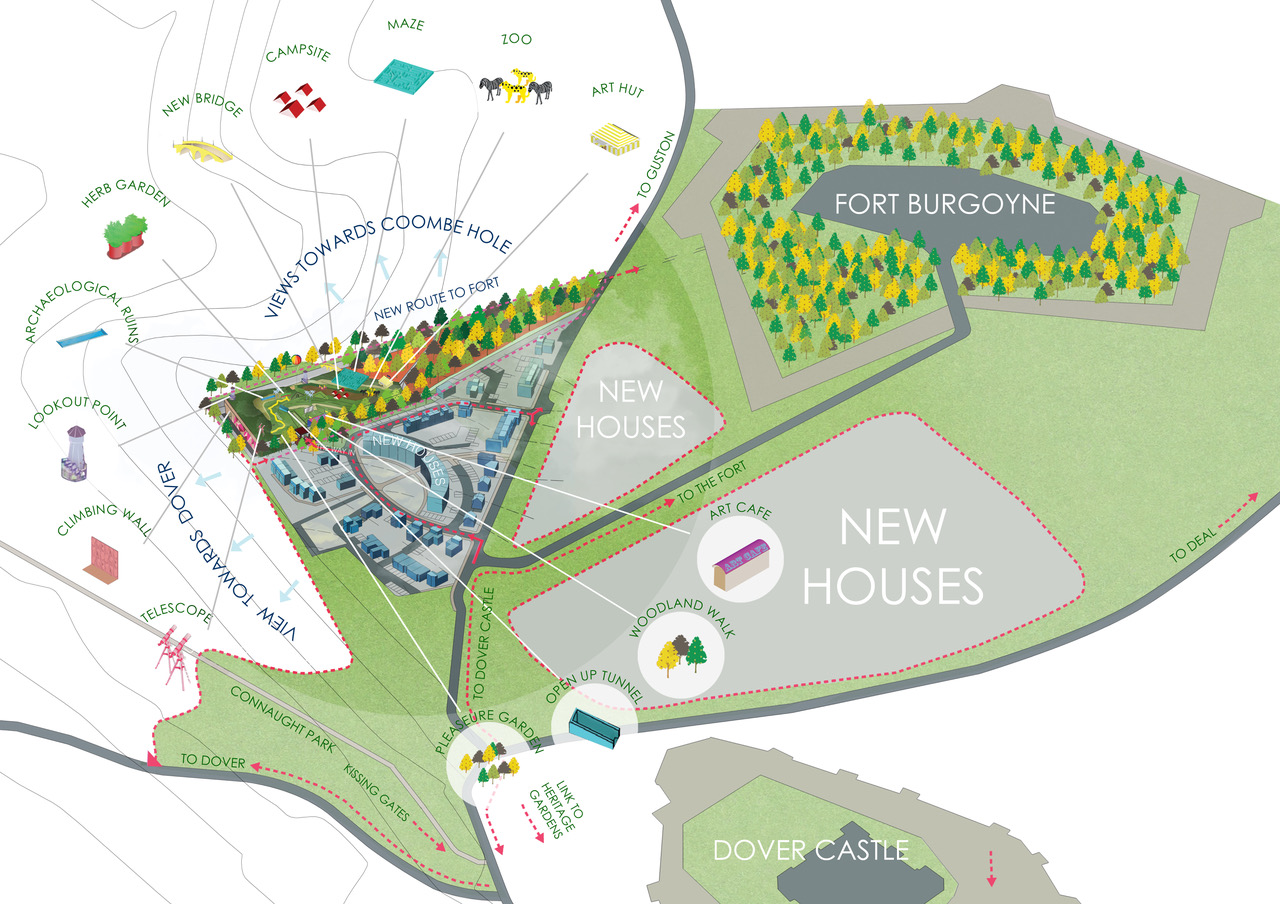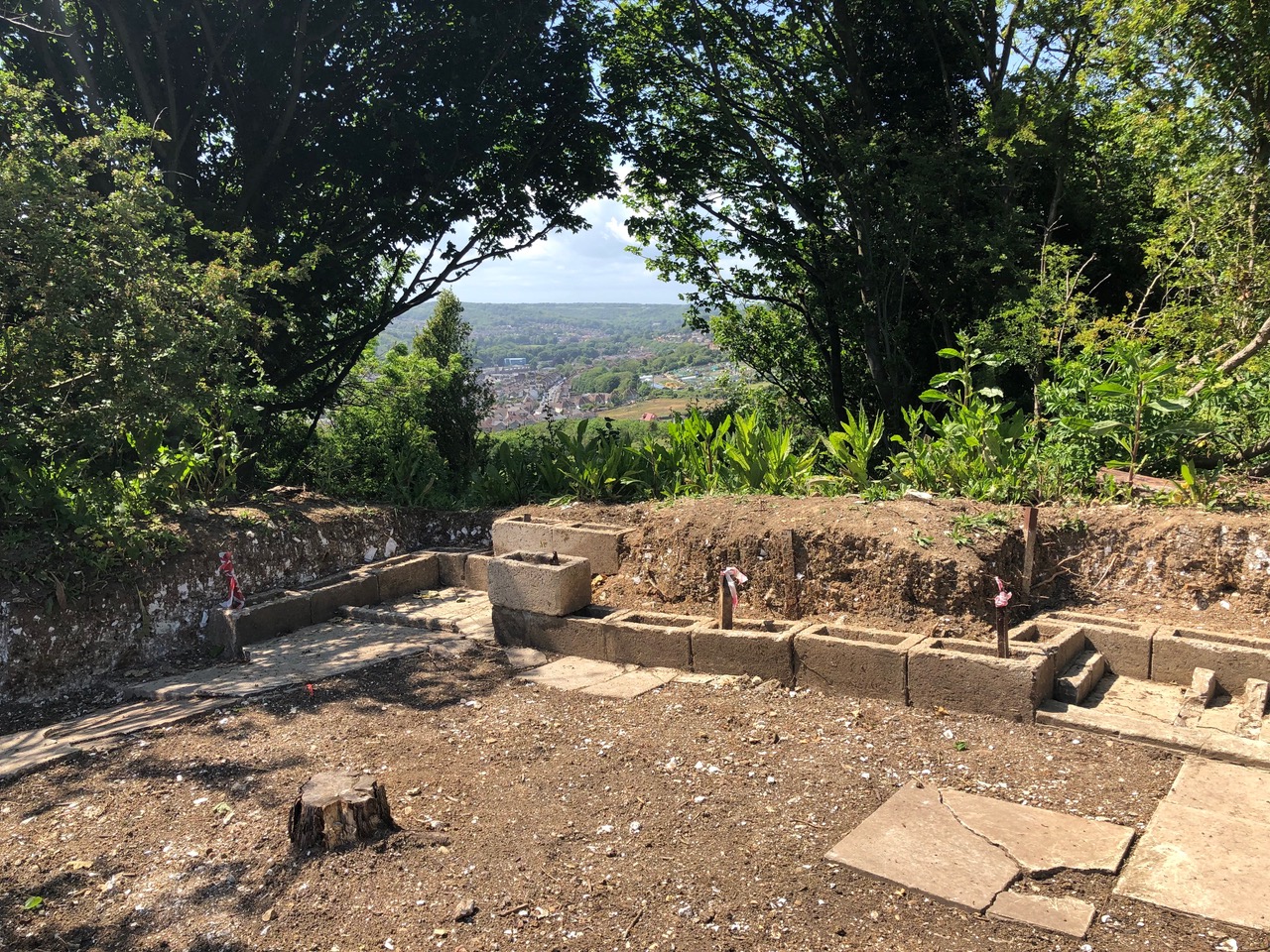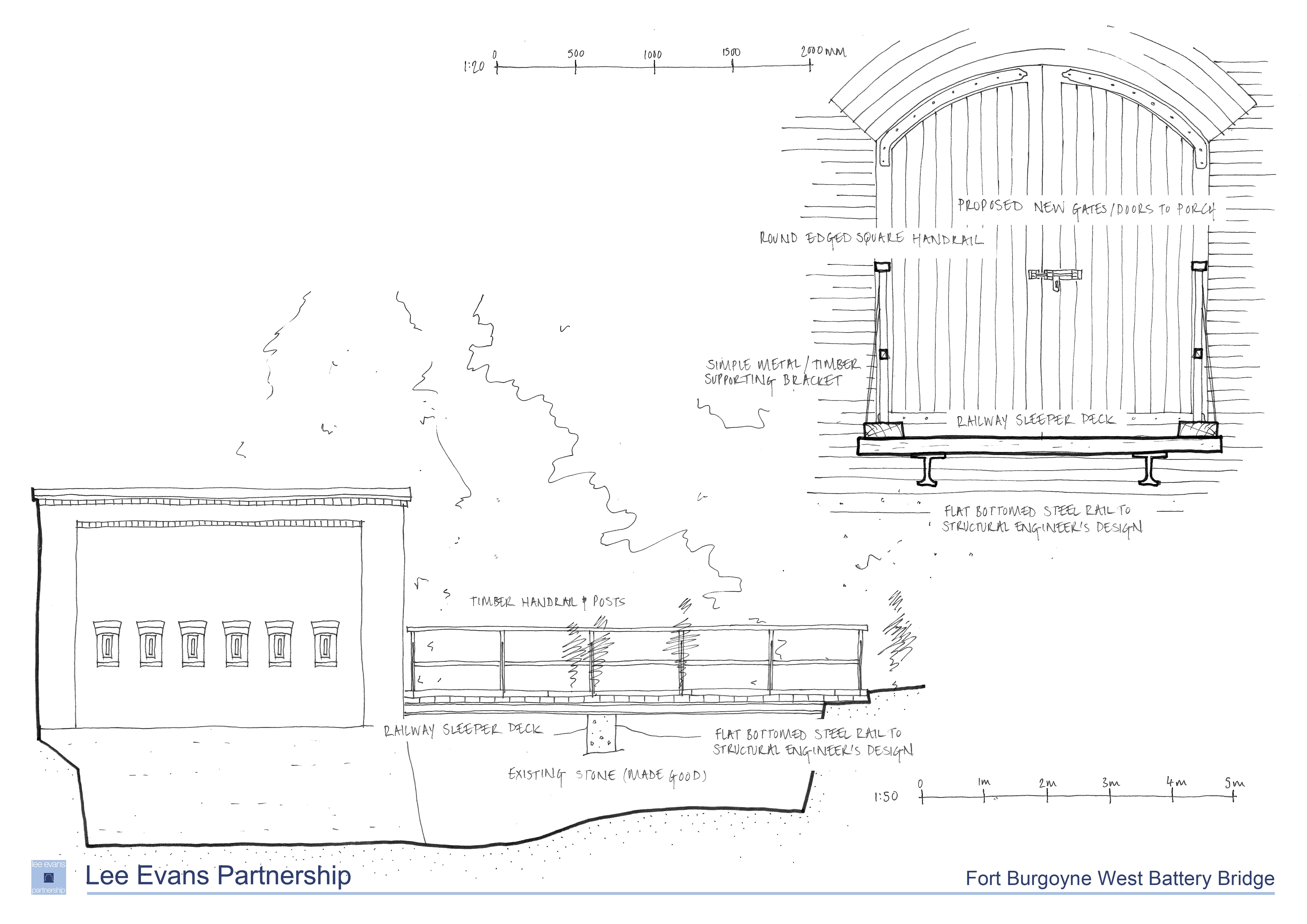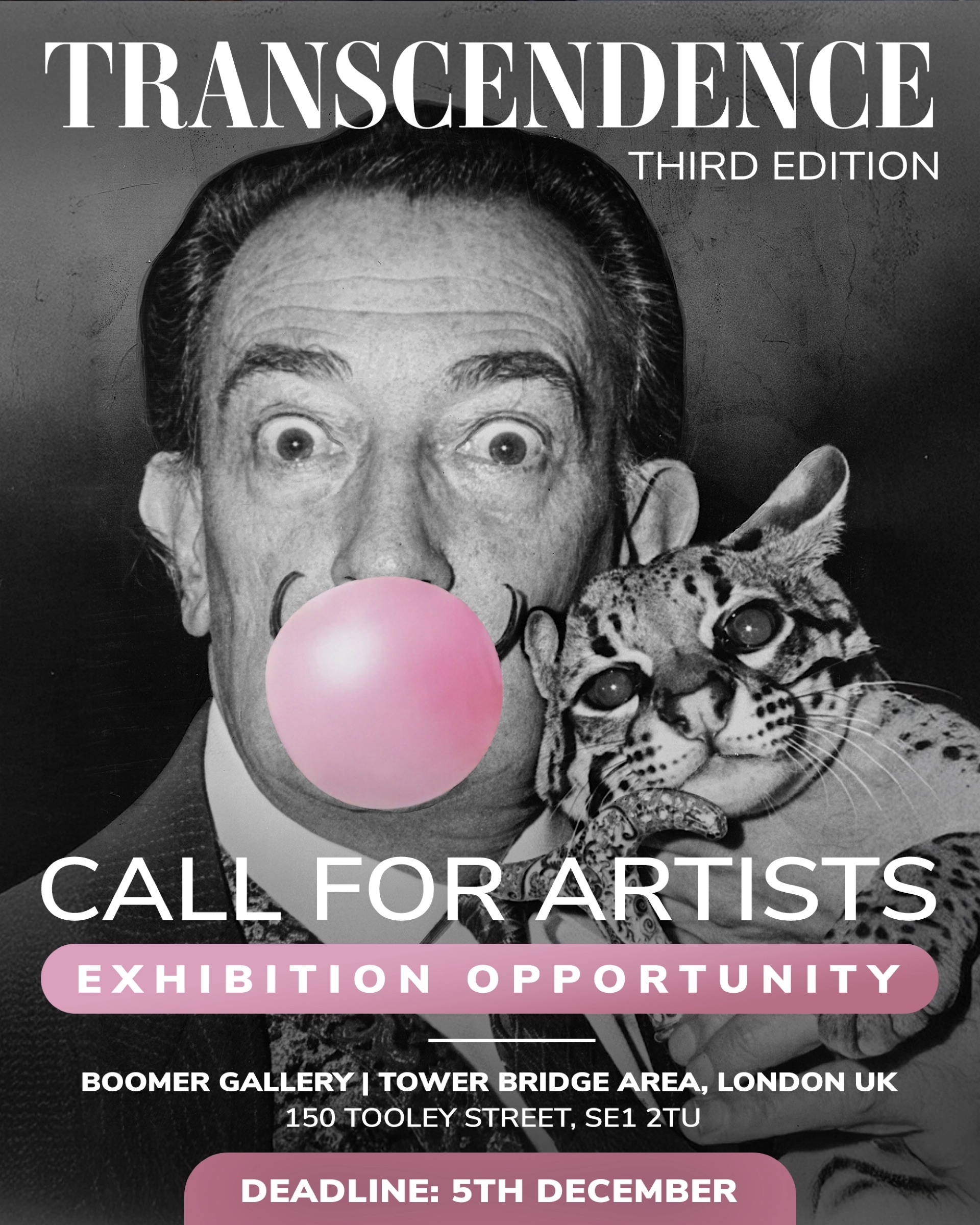Expressions of Interest invited: Public Art Commission for a Scheduled Ancient Monument in Dover
Deadline: 06/09/2019Venue: West Wing Battery of Fort Burgoyne | City: Dover | Region: Kent | Country: United Kingdom | DAD (Dover Arts Development)
Paid opportunity
Dover Arts Development, on behalf of the Land Trust, are looking to commission an artist to create an artwork for the West Wing Battery at Fort Burgoyne Dover as part of the Pioneering Places: East Kent project. The artwork should enhance the site for local residents, tourists and new residents of the adjacent planned housing estate. The work should help to deliver interpretation for the site and facilitate long-term community activity.
CONTEXT: Site and Setting
The West Wing Battery is a Scheduled Ancient Monument and part of the wider Fort Burgoyne complex, a remarkable military site originally built in the 1860s to defend Dover from invasion and in permanent military use until 2006. The West Wing Battery was once connected to the main area of Fort Burgoyne via a ditch network.
The Battery has stood unused for circa 70 years. In 2019, Homes England secured reserved matters planning consent for the construction of 64 housing units on the former Officers Mess adjacent to the Battery. The site is now under the control of housing developers to build the houses. In response to this development, the Land Trust Board has approved the development of a scheme to conserve and enable public access to the Battery.
Pioneering Places: East Kent funding was secured by The Land Trust in March 2018 to develop a relationship with the Dover community in order to inform plans for access, deliver interpretation for the space and facilitate long-term community activity. In January 2019 Dover Arts Development and Charles Holland Architects were appointed to work on the development of future uses for the site and Lee Evans Partnership were appointed to undertake conservation and stabilisation work.
Since then the site has been uncovered through:
- A community engagement programme of Explorers Sunday morning walks which mapped the West Wing and its relationship to Dover through the lens of military and architectural history as well as lived and day-to-day experience. http://www.dadonline.eu/projects/the-explorers-west-wing-battery-community-engagement-programme-at-fort-burgoyne/.
- A 'Big Drawing' (see Gallery) that records ideas for the site's future uses identified during the Explorers walks.
- An Archeological dig organised by Canterbury Archaeological Trust
- Survey and stabilization work specification by Lee Evans Partnership commencing on site on 22 July 2019.
Pioneering Places: East Kent
Pioneering Places is part of the national Great Place Scheme, an ambitious project that will make East Kent an even better place to live, work and visit by exploring heritage, developing civic pride and connecting artists and communities. Four projects in Canterbury, Dover, Folkestone and Ramsgate are being led by cultural organisations to encourage local people to get involved and shape the place where they live. Supported through Arts Council England and the National Lottery Heritage Fund, with Historic England and Artswork, the South East Bridge.
KEY ELEMENTS of the PROPOSAL
The commissioners have identified four areas of the West Wing Battery site for the artists' consideration (see Gallery)
- The soft boundary between the new housing estate and the West Wing Battery Boundary ditch
- The Gate House
- The Viewing Point (top left as you enter the site)
- The Arrival Area
The artist should bear in mind the following challenges:
- Access to the site is over a narrow bridge. A temporary bridge is in place and a design for a permanent replacement is being developed (see Gallery)
- The site is a Scheduled Ancient Monument and as such any works or additions to the site will require scheduled monument consent. Lee Evans partnership and the Land Trust will advise and support the artist with this.
PURPOSE AND OUTCOMES
- Create awareness of the West Wing Battery
- Enhance the West Wing as a destination
- Enrich the visitor experience
- Enable a sense of ownership for local people
- Enhance Dover's tourist offer for heritage and culture
- Inspire people to walk and explore
- Deliver interpretation for the space
- Facilitate long term community activity
SUBMISSION OVERVIEW
The Land Trust and partners are looking for creative solutions to this brief, given the proposed location, its Scheduled Ancient Monument status, timescale and budget.
Artists are asked to state the life expectancy of their artwork to inform the Scheduled Monument application and management planning and give an indication of required maintenance.
The opportunity is suitable for:
- Established artists with a proven track record of working to a tight brief and limited budget in the public realm with at least 5 years in practice.
- Artists who can demonstrate how their work would respond to the Scheduled Ancient Monument site.
- Artists who are prepared to fully commit the time necessary to the process and to ensure that the opportunity is maximised.
The selected artist will be expected to:
- Work closely with the commissioners
- Attend meetings with the partners
- Consult with the projects conservation architect for restrictions and advice on positioning a new work on a Scheduled Ancient Monument site and securing Scheduled Monument Consent
- The artist will be required to provide information necessary to support a planning application (if appropriate). The commissioners consultant team will lead on the application
- Work to set deadlines
- Be prepared to be open about their process and share/show work in progress
- Be prepared to make a contribution to the Pioneering Places and Land Trusts ongoing programme by giving a talk or contributing to an event
- Be prepared to make a contribution to commissioners websites and social media campaigns (e.g. images/video podcast/ written contribution)
- Work with the commissioners to ensure health and safety requirements are met
- Have public liability cover of up to £5,000,000 and must provide The Land Trust with proof of cover throughout the project period and until Land Trust takes on the maintenance.
BUDGET
The budget is up to £17,500 (inc VAT) to cover fee, materials, installation, travel and out-of-pocket expenses, planning fees (if required).
Dover Arts Development can provide a subsidized artists residency space for the selected artist within walking distance of the site subject to the artists requirements and availability.
TIMELINE
Expression of Interest deadline: Midnight, 6th September 2019
All artists will be notified by Friday 20th September 2019.
Up to five artists will be invited to develop their Proposals.
They will be given £500 and will be able to visit the site on Wednesday, 25th September 2019.
We regret it is not possible to give feedback for unsuccessful applications.
Deadline for shortlisted artists proposals Friday 1st November 2019.
Completion of Artwork including installation Friday 19th June 2020.
HISTORICAL BACKGROUND TO FORT BURGOYNE
Dover Castle developed over many centuries, with the development of military weapons during the 19th Century a fundamental weakness in its defences was realised from the high ground to the north and north east. During the period in the 19th Century as Napoleon was threatening to invade the British Isles this weakness became more important to be resolved.
During the later eighteenth- and nineteenth-centuries massive programmes of new defence work were undertaken, particularly around the vulnerable northern side of the existing castle complex, in an effort to strengthen this side against landward attack. As fortifications, most other medieval castles had long since become obsolete by this time but due to its key location, Dover Castle continued to be of great strategic importance.
During the 1850s and 1860s a Royal Commission was appointed to look at the weaknesses of the southern coast of England to ensure it was able to resist invasion. The work started on the construction of the fort in 1861 and it was completed by the end of 1868. Originally, this was to be known as Castle Hill Fort but it was soon renamed Fort Burgoyne in honour of Field Marshall W.F.D. Burgoyne, Inspector General of Fortifications.
The keep of Dover Castle lies some 800 metres to the south and the Citadel of the Western Heights fortress some 2.75 km to the south-west. The natural subsoil in the area of the fort consists of Clay-with-Flints, over chalk of the Seaford Chalk Formation.
The layout of Fort Burgoyne is polygonal, enclosed by a deep and wide ditch. At the centre is a parade ground surrounded on three sides by casemented barracks protected by a covering of earth. The main gun positions, mostly facing inland, were set on a terre-plein above the casemates. The bomb-proof casemates under the main ramparts originally provided accommodation for seven officers and 270 men. One of the more unusual features of the fort's layout are two contemporary but detached wing batteries, positioned beyond the main work and connected to the central fort by spur ditches (East Wing Battery and West Wing Battery). Each battery was provided with its own emplacements for field guns.
In the twentieth century, the fort saw continued service during both World Wars. In 1940, along with the adjacent castle, it was incorporated into the fortified ‘Stop-line’ that extended some 34 km between Dover and Whitstable intended to hold up enemy invaders landing in the north-eastern part of the County. New works added then included pillboxes, slit trenches, weapon pits, and spigot mortar emplacements, located in and around the main fort and at the West Wing battery, with a barrage balloon moored just to the south-east of the battery. Amongst the more unusual additions to the main fort were fixed concrete emplacements for two batteries of 25 pounder field guns.
The importance of Fort Burgoyne is two-fold. Firstly, it constitutes an important and well preserved representative of a later nineteenth century polygonal fortification in Britain, containing a number of unusual features. Secondly, it forms an essential part in the sequence of Dover's surviving artillery defences.
The Western Battery
While it is a separate defensive structure in the landscape, the western battery is physically connected to the main fort via a ditch which today has been filled in, possibly during the second war. The purpose of the western battery was two-fold, the first was to repel an enemy invasion firing its weaponry on an invading force. The second function was to provide the main fort with supporting fire, if an invading army were to be at a point of over running the main fort, the outlying battery's would have been called upon to provide artillery support to defend or to retake the main fortification on the high ground.
This dual function of the fort required flexibility for its functioning. This would explain the layout of the fort which housed its artillery within a gun shed, where they would be kept out of the weather while not in use. Two ramps led from this shed to the raised ramparts where the artillery could be manoeuvred to their desired locations to provide fire to the areas as required. Unlike the main fort the west battery had no fixed gun emplacements.
To serve this flexible firing upon the rampart, two small magazines were provided with bomb proof earth covered roofs built upon the ramparts so that troops could quickly access ordinance during any battles.
During the second world war, the battery was used as a defensive position for both anti-aircraft and against any possible land invasion. Trenches were dug and other positions the remains of which are still present in areas of the battery today.
During the second half of the 20th century the battery fell out of use by the military, this may have been due to the technological development of the British Army and how they trained and fort. The officer's accommodation for Connaught barracks were positioned adjacent to the western battery and this may have increased the battery's isolation and reluctance to be used – it has been noted that during this time the camp commander used areas of the battery as his unofficial and personal garden.
A Scheduled Ancient Monument
Due to the national uniqueness and important history of the Fort Burgoyne site and its role throughout time in the nation's defensive measures, the site was scheduled as a Scheduled Ancient Monument by the government making the site protected under the Ancient Monuments and Archaeological Areas Act 1979 to protect the site for future generations.
What is a Scheduled Ancient Monument? Not all scheduled monuments are ancient. Monuments and archaeological remains of all dates can be given the protection of scheduling, whether they are prehistoric burial mounds, 20th-century remains of the coal industry or from World War II. Some scheduled monuments contain standing buildings or ruins. Others have no visible remains above ground: it is the buried archaeology that is of national importance. Sometimes the form and layout of monuments only becomes clear from the air or through geophysical survey.
Scheduling is carefully restricted to the most important examples of each type of monument and to those for which this type of designation provides the most appropriate protection.
While Scheduled Monuments are often archaeological sites, Fort Burgoyne has a substantial structure across the site, these structures are also present in the east and west battery's, this requires the structure and below ground strata to be equally protected. The below ground material is protected by the ground, therefore the ground is to be protected and any digging or disturbance to the ground is to require robust justification to Historic England through a Scheduled Monument Consent, who have the legal power to protect the site and permit, or refuse, proposed actives on or around a Scheduled Monument. Therefore, very careful thought and consideration must be given to any item or movement on the ground surface of the site, any penetration of the ground may be justifiable to have the impact it will have on the national importance of the site.
Standing above ground structures are not protected and cocooned within the ground like archaeology is, as they are exposed to the weather and all the erosion which that creates. Therefore, the challenge which needs to be overcome for any preservation of the standing structure, is to preserve the national importance of the structure. The ideal situation is that any above ground structure is maintained on a regular basis to minimise erosion, unfortunately the structures across the fort site have been neglected for a considerable amount of time, even when the MOD had done repairs, they were done with materials which were damaging to the structures longevity and preservation. This neglect has led to invasive repairs being required to the standing structure of the west battery, to return the fort to the state which would have been if maintenance had been carried out.
The dilemma which is created by this work has been to try and be honest while respecting the preservation of the structures of the site. The site is a palimpsest of alterations and interventions, therefore it is important that the works being done to preserve the structure are read as such and allow the site to be honestly read without harming the national importance of the site and structures within it.
Any physical intervention within the west battery will require thought to be given to its harm and its harmless reversibility, to respect the reverence and importance of the site and the reasons for its importance.
Fort Burgoyne: Political Context.
Despite having entered the Napoleonic era regarded by many as a spent force, Britain had emerged from the 1815 Congress of Vienna as the ultimate leading financial, military and cultural power of the world, going on to enjoy a century of global dominance. France also recovered from its defeats to retake its position on the world stage. Through political friendly approaches, albeit lacking in direction, the British and French eventually became political allies, as both began to turn their attentions to acquiring new territories beyond Europe. The British developed India and Canada and colonized Australia, spreading their powers to several different continents as the Second British Empire. Likewise the French were quite active in Southeast Asia and Africa.
They frequently made stereotypical jokes about each other, and even side by side in war were critical of each other's tactics. As a Royal Navy officer said to the French corsair Robert Surcouf, "you French fight for money, while we British fight for honour", Surcouf replied, "Sir, a man fights for what he lacks the most". According to one story, a French diplomat once said to Lord Palmerston, who the Palmerston Forts were named after, "If I were not a Frenchman, I should wish to be an Englishman"; to which Palmerston replied: "If I were not an Englishman, I should wish to be an Englishman”. Eventually, relations settled down as the two empires tried to consolidate themselves rather than extend themselves.
British Foreign Secretary Viscount Palmerston allied himself with French monarch Louis-Philippe. In 1830, France underwent the July Revolution, and the Orléanist Louis-Phillipe subsequently ascended to the throne; by contrast, the reign of Queen Victoria began in 1837 in a much more peaceful fashion.
During the reign of Emperor Napoleon III of France, Lord Aberdeen (foreign secretary 1841–46) brokered an Entente Cordiale with François Guizot and France in the early 1840s. However Louis-Napoléon Bonaparte was elected president of France in 1848 and made himself Emperor Napoleon III in 1851. Napoleon III had an expansionist foreign policy, which saw the French deepen the colonisation of Africa and establish new colonies, in particular Indochina. The British were initially alarmed, and commissioned a series of forts in southern England designed to resist a French invasion. Lord Palmerston, as foreign minister and prime minister, had close personal ties with leading French statesmen, notably Napoleon III himself. Palmerston's goal was to arrange peaceful relations with France in order to free Britain's diplomatic hand elsewhere in the world.[69] Napoleon at first had a pro-British foreign policy, and was eager not to displease the British government whose friendship he saw as important to France. After a brief threat of an invasion of Britain in 1851, France and Britain cooperated in the 1850s, with an alliance in the Crimean War, and a major trade treaty in 1860. However Britain viewed the Second Empire with increasing distrust, especially as the emperor built up his navy, expanded his empire and took up a more active foreign policy.
The two nations were military allies during the Crimean War (1853–56) to curb Russia's expansion westwards and its threats to the Ottoman Empire. The two nations also co-operated during the Second Opium War with China, dispatching a joint force to the Chinese capital Peking to force a treaty on the Chinese Qing Dynasty and in 1860 the Cobden-Chevalier Treaty was signed between the two countries, reducing tariffs on goods sold between Britain and France.
When Napoleon III was overthrown in 1870, he fled to exile in England.
In the 1875-1898 era, tensions were high, especially over Egyptian and African issues. At several points, these issues brought the two nations to the brink of war; but the situation was always defused diplomatically. For two decades, there was peace – but it was "an armed peace, characterized by alarms, distrust, rancour and irritation". During the Scramble for Africa in the 1880s, the British and French generally recognised each other's spheres of influence.
Contact the curator
• Artists who can demonstrate how their work would respond to the Scheduled Ancient Monument site.
• Artists who are prepared to fully commit the time necessary to the process and to ensure that the opportunity is maximised.
• Attend meetings with the partners
• Consult with the projects conservation architect for restrictions and advice on positioning a new work on a Scheduled Ancient Monument site and securing Scheduled Monument Consent
• The artist will be required to provide information necessary to support a planning application (if appropriate). The commissioners consultant team will lead on the application.
• Work to set deadlines
• Be prepared to be open about their process and share/show work in progress.
• Be prepared to make a contribution to the Pioneering Places and Land Trusts ongoing programme by giving a talk or contributing to an event.
• Be prepared to make a contribution to commissioners websites and social media campaigns (e.g. images/video podcast / written contribution)
• Work with the commissioners to ensure health and safety requirements are met
• Have public liability cover of up to £5,000,000 and must provide The Land Trust with proof of cover throughout the project period and until Land Trust takes on the maintenance.
Artists will be notified by September 20th 2019
From the Expressions of Interest up to five artists will be given £500 each and invited to develop their proposals and visit the site on the 25th September 2019.
Full Proposal Deadline Friday, 1st November 2019
Completion of Artwork including installation 19th June 2020
Dover Arts Development can offer a subsidized artists residency space for the selected artist within walking distance of the site subject to the artists requirements and availability.
You must have an account to send a message to the curator of this opportunity. Registering only takes a few moments. Once registered you'll be able to keep track of all of your submissions and get updates on upcoming opportunities.
Already have an account? You must log in to send this curator a message.
Get the latest CuratorSpace news, updates about new opportunities, upcoming deadlines, and art-related promotions.
OPEN CALL ARTISTS OF THE SEASON - Submit Now for an opportunity to get featured for the WINTER... Mini Christmas Bazaar – Call for Artists!
🎄✨ Mini Christmas Bazaar – Call for Artists! ✨🎄 Christmas exhibition
When festive times approach, we think of celebration, getting together with close ones,...







